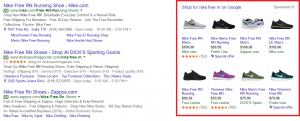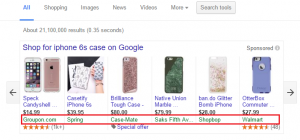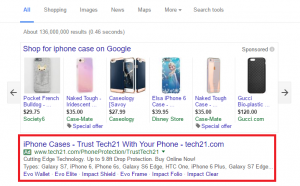Shopping Ads in the Google SERP Are Now Scrollable

Google’s search engine results page (SERP) has been the subject of quite a few ad layout changes this year. In February, the company incorporated changes in how text ads would be displayed. The infamous right sidebar ads would no longer be shown. Instead, the number of text ads displayed above and below organic results were increased to 4 and 3, respectively. Now, product listing ads (PLAs) are next in line to see updates in the Google SERP as well.
Product listing ads shown in the main Google SERP are far from being a new development.
When a user enters a product-specific search query, they’re presented with organic results and a string of PLAs tied to the Shopping platform.
This layout has been structured into the Google SERP for quite some time now.
At first glance, not much.
It appears that the number of PLAs being shown in the Google SERP on both mobile and desktop platforms have increased, providing more placements for ads in the sponsored section located at the top of the search page.
Originally, the format for Shopping ads shown in the Google SERP housed as many as 12 PLA positions, often stacking one row of 6 or 4 on top of another. These PLAs would be displayed on the right side or at the top of the main Google SERP.

Now, we have recently started to see as many as 18 spots available for product listing ads on certain search queries, with the new format implementing the use of a scroll bar instead of the stacked-type of display.
In the example below, the search term used was “womens joggers”, which produced 17 PLAs in the Google SERP.

Additionally, similar changes were seen in the mobile SERP as well. The scroll bar, which has usually displayed around 6-8 PLAs in mobile browsers, is now showing upwards of 15 positions.
While the change, in itself, is a fairly subtle one, this stands to represent a pretty significant update for a number of reasons.
This is shaping up to be a pretty important update for retailers and marketers with ads on Shopping. The impacts may not be immediately tangible, but we can allude to what this will mean for retailers.
The spike in the number of PLAs means a greater volume of retailers stand to gain more visibility. With more positions available, small-to-mid size retailers are presented with more opportunities to compete with big-budget businesses that typically dominate the space.
“As PLAs get more and more expensive, it’s begun to consolidate the amount of advertisers that can actually compete for these spots,” said Lewis Brannon, Paid Search Manager at CPC Strategy.
“I think these changes are an attempt to prevent small-to-mid-size advertisers from being discouraged about competing for those hard-to-win spots.”
In a search now, you’ll see manufacturers, big brands, and small or medium size retailers. There’s diversity in the shopping ads shown in the Google SERP; which hasn’t always been the case.

”It’s opening more opportunities for a wider array of advertisers in the Shopping space.”
It’s no secret that people like variety. More options are usually a good thing. Now, with these changes to Shopping ads, users have the ability to view a bunch of products in a matter of seconds.
“This format is definitely going to provide a better user experience,” Brannon went on to say.
“As a consumer, I don’t necessarily want to always have to click on the Shopping tab. I just want the results I’m looking for as quickly as possible.”
“As long as Google can provide the most relevant results, and provide users more of them in an easy-to-view format like this; I think it improves user experience a lot.”
This should be nothing but good news for advertisers and retailers. The more enjoyable the experience is for users, the more incentive they have to spend more time on the ads they’re shown.
More importantly, it gives retailers in lower spots, who would not otherwise be listed on the SERP, more visibility outside of the Shopping tab.
At this point, we can only offer speculation, but the new changes to product listing ads shown in the Google SERP open up a lot of different possibilities.
Taking into consideration that there is more diversity in the amount of advertisers in the auctions, retailers may not always be competing against the big-budget brands – and that could potentially even out cost-per-clicks, making them cheaper.
However, it could very well have the opposite impact. Because there are more overall people in the auction, it could start driving up cost-per-clicks. Until more time has passed to better gauge these impacts, it can be difficult to predict.
Another area that may be affected is text ads being displayed alongside Shopping ads shown in the Google SERP.

Because users have so many options at the top of the SERP, they may not have as much incentive to go down to the text ad. As a result, this may mean that click-through-rates on these text ads might see a decrease.
This may also cause some changes to how ads are displayed in search queries as well.
“So imagine being an appliance retailer, and you have a refrigerator that has, historically, performed well under a specific search query.”
“Because there are more PLA positions, Google might start to throw you in the mix for more of these very top-of-the-funnel, general type of searches.” (Think “Samsung 30.4in Stainless Steel Refrigerator” versus “Samsung Fridge”)
“This could potentially cause your cost in clicks to start rising. So as a small-to-mid sized retailer, that’s something to look out for.”
What’s particularly interesting about the increase in listings is the fact that it has been implemented rather quietly. Google chose to refrain from making any type of official statement and the changes were rolled out in a subtle manner.
Which isn’t totally surprising, either. The company makes changes to formats on the SERP all the time, so this is likely an internal beta test.
“I’d imagine they’re just trying to test what impact this has on the distribution of clicks. What impact this has on advertiser spend into Google Shopping. They’re probably just trying to gauge the impact before they make an announcement” Brannon noted.
“It’s something they typically do. From minor things like the color of ad labels, to something as major as this. I think they’re just testing.”
For more information on Shopping ads in the Google SERP, please contact [email protected]
Introducing New Google Shopping Ad Rank for Top Product PLAs
How Google’s Discontinuation of Right Side Ads Will Impact Retailers
